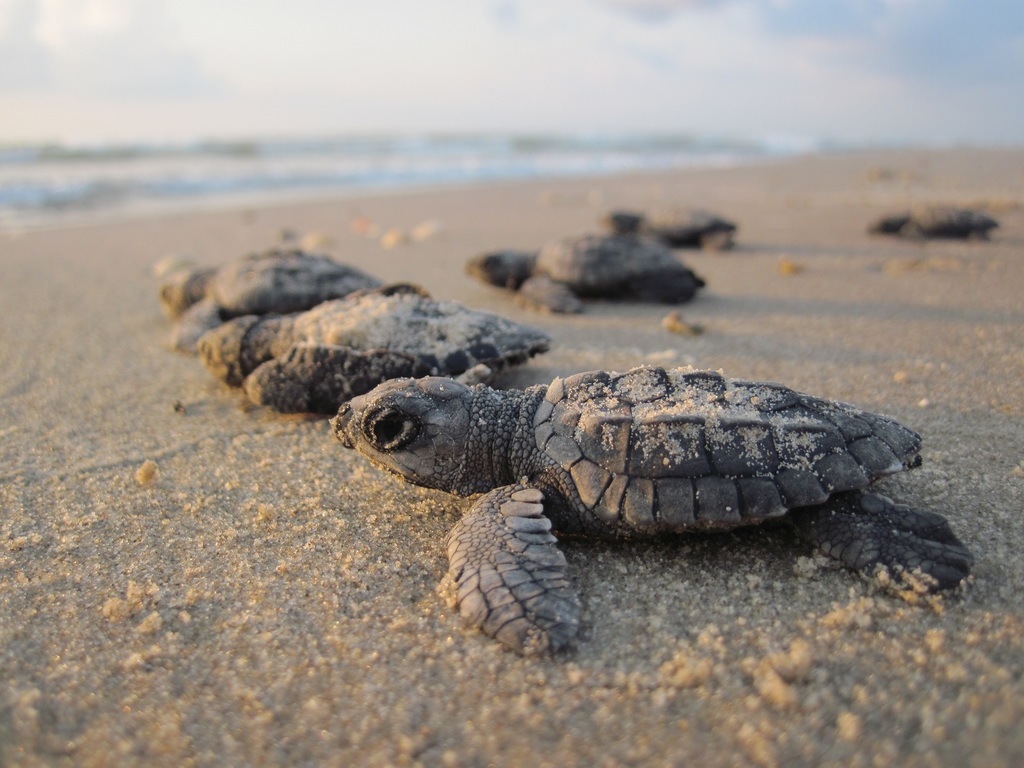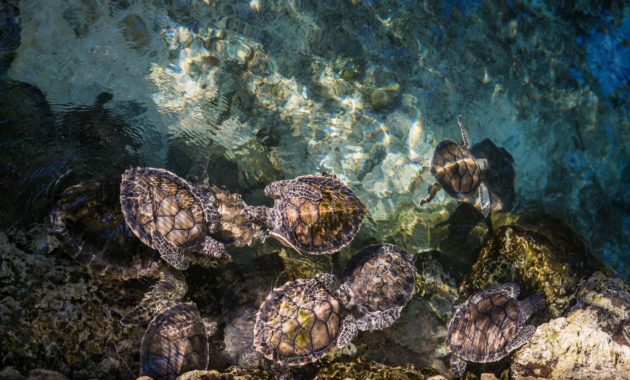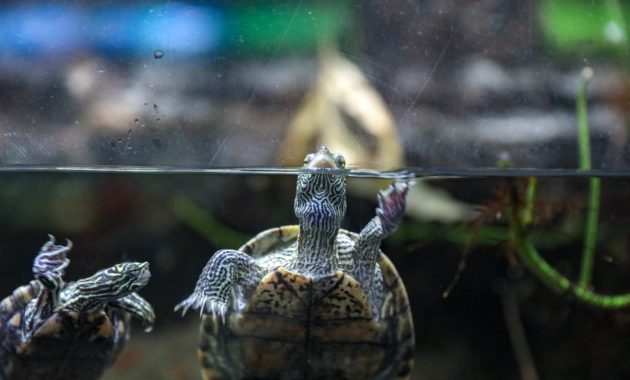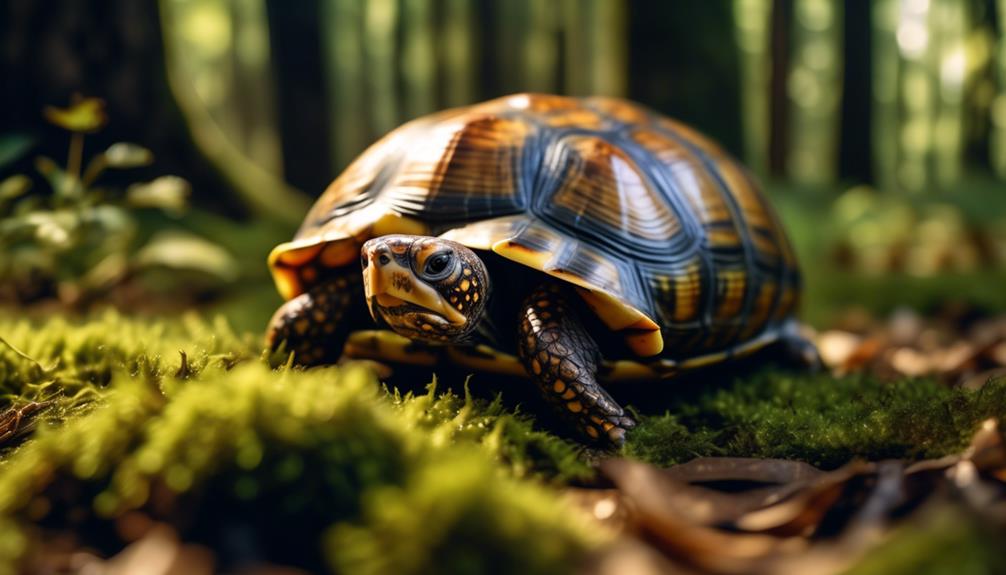
Did you know that amidst the vast array of turtle species, there exists an elusive creature known as the Florida Box Turtle? This captivating native species, with its distinctive characteristics and unique behavior, has managed to pique the interest of both experienced turtle owners and enthusiasts alike.
From its domed shell and mesmerizing coloration to its secretive nature, the Florida Box Turtle leaves many questions unanswered. In this article, we will embark on a journey to unveil the mysteries surrounding this fascinating turtle, exploring its habitat, appearance, care requirements, and intriguing behavior.
Get ready to discover the enigmatic world of the Florida Box Turtle and satisfy your curiosity about this captivating creature.
Key Takeaways
- Florida Box Turtles are small terrestrial turtles with a highly domed shell and distinctive yellow markings.
- They are native to Florida and southern parts of Georgia, and can be found in marshes, scrub areas, and forests.
- These turtles have a lifespan of 50+ years and require a varied diet of commercial food, vegetables, fruits, worms, and insects.
- Florida Box Turtles are best housed in outdoor enclosures with secure fencing, sunlight, shaded spots, and a humid environment. They are generally not fond of being handled but are fun to observe.
Size and Characteristics
The Florida Box Turtle is a small terrestrial turtle with a highly domed shell and distinct physical characteristics. They typically measure between 4 to 6 inches in length, making them quite small in size. These turtles have a unique shell that’s highly domed and features a hinge for complete enclosure. The back of the shell slightly flares outward, giving them a distinct appearance.
They’ve four toes on their back feet, which helps them navigate their terrestrial habitat. Female Florida Box Turtles have brown or dark red eyes and a flatter plastron, while males have orange or bright red eyes, a longer and thicker tail, and a hooked claw on their back feet. Their shell is black with thick yellow lines on the sides of their head, making them easily distinguishable.
Native Habitat and Range

Florida Box Turtles can be found in their native habitat of Florida and the Florida Keys, as well as in the southern parts of Georgia. These fascinating creatures inhabit a variety of environments, including marshes, scrub areas, and forests. They’ve adapted to survive in these habitats and have become an integral part of the local ecosystem.
The range of the Florida Box Turtle is quite limited, making it a unique and special species to encounter. Their presence is a testament to the diversity and richness of the natural world. By understanding and appreciating their native habitat and range, we can work towards preserving and protecting these incredible turtles for future generations to enjoy.
Distinctive Features and Appearance
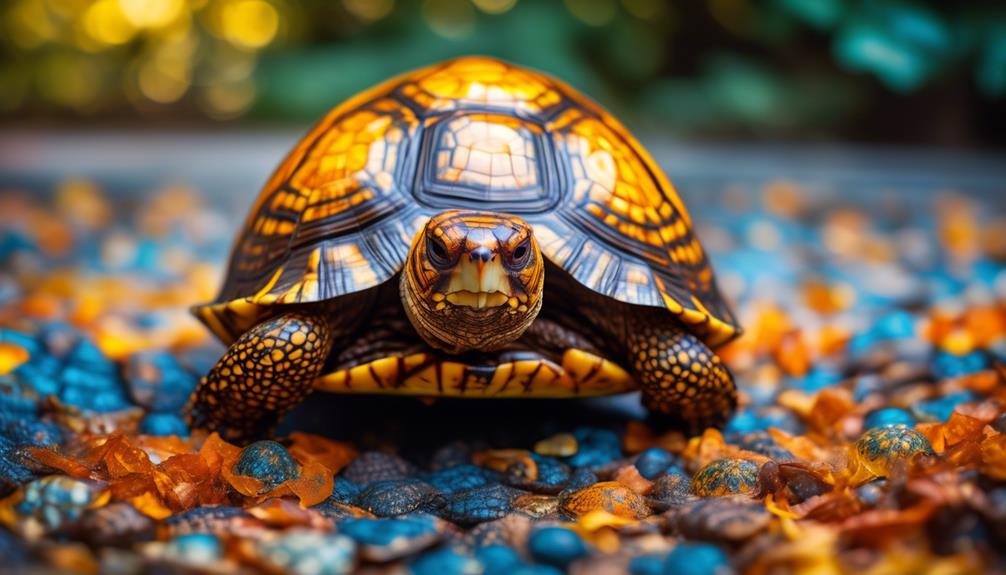
With its highly domed shell and unique coloration, the Florida Box Turtle stands out among other native turtle species. The shell is characterized by a pronounced dome shape and a hinge that allows the turtle to fully enclose itself for protection. The back of the shell slightly flares outward, giving it a distinctive look.
In terms of color, the Florida Box Turtle shares similarities with the Western Ornate Box Turtle, but it has more yellow markings. The shell is predominantly black, with thick yellow lines on the sides of the head.
Additionally, the appearance of male and female turtles differ. Females have brown or dark red eyes and a flatter plastron, while males have orange or bright red eyes, a longer and thicker tail, and a hooked claw on their back feet.
Housing and Enclosure Requirements
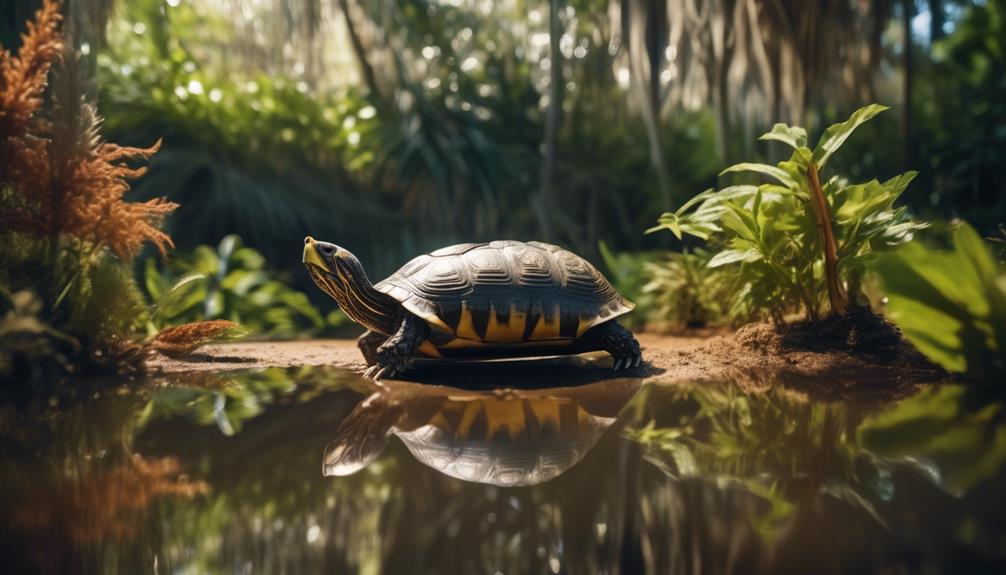
To properly house and care for a Florida Box Turtle, it’s important to provide an appropriate enclosure that meets their specific needs. Here are some key considerations:
- Size: Ensure that the enclosure is spacious enough for the turtle to move around comfortably and engage in natural behaviors.
- Security: Create a secure enclosure using cinder blocks or wood, along with fencing and an underground barrier to prevent escape.
- Environment: Provide a mix of sunlight and shaded spots within the enclosure, as well as a water dish and moist substrate to maintain the required humidity levels.
Environmental Considerations
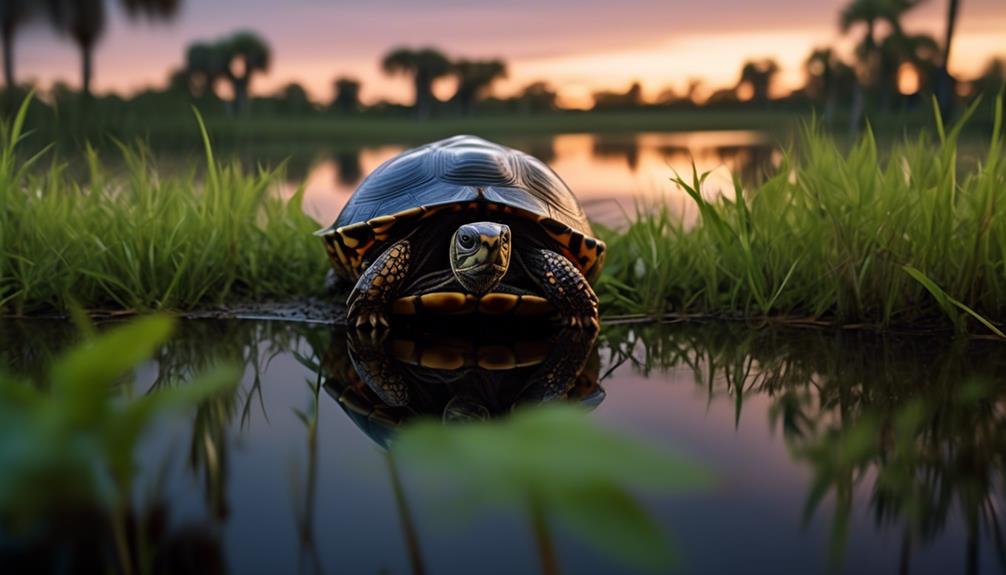
Now let’s shift our focus to the important environmental considerations for housing a Florida Box Turtle.
These turtles are best housed in an outdoor enclosure that provides both sunlight and shaded spots. To ensure their safety and prevent escape, use cinder blocks or wood to create a secure enclosure. Install fencing and an underground barrier to further prevent any potential escape.
It’s crucial to maintain a humidity level of 70-90% within the enclosure, so make sure to provide a moist substrate and a water dish.
Additionally, the environment should include a variety of invertebrates, plants, and insects for the turtles to feed on. Remember to offer a commercial diet for turtles and supplement their food with vitamins and calcium.
Lastly, ensure multiple water dishes or a large water area to accommodate multiple turtles.
Feeding and Diet Recommendations
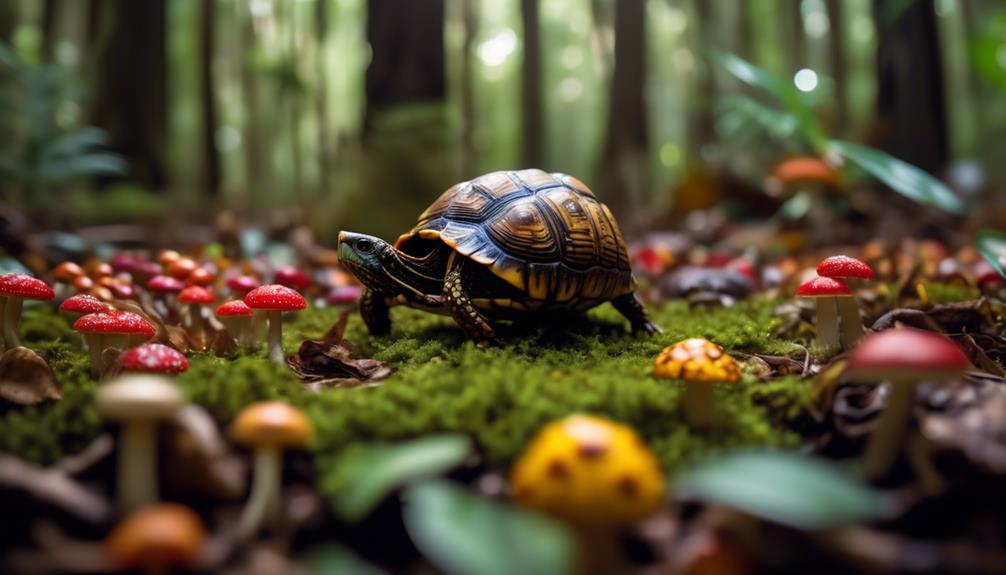
When considering the feeding and diet recommendations for Florida Box Turtles, it’s important to provide a diverse range of invertebrates, plants, and insects. This ensures that they receive the necessary nutrients for their overall health and well-being.
Here are three key points to keep in mind when feeding your Florida Box Turtle:
- Offer a variety of invertebrates: Include worms, snails, slugs, and beetles in their diet. These provide essential proteins and fats that are crucial for their growth and development.
- Incorporate plants and vegetables: Provide a mix of leafy greens, such as kale, collard greens, and dandelion greens. Additionally, offer a variety of fruits like strawberries, melons, and berries as occasional treats.
- Include insects: Introduce small insects like crickets and mealworms into their diet. These not only add variety but also stimulate their natural foraging behavior.
Nutritional Supplements and Treats
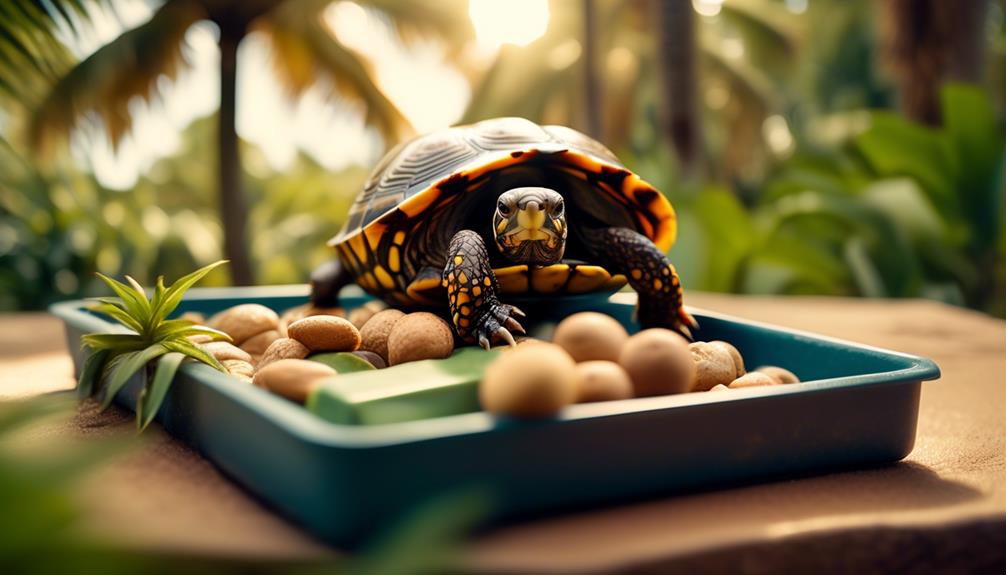
Include a variety of nutritional supplements and treats to enhance the diet of your Florida Box Turtle.
Along with a pelleted commercial diet, vegetables, fruits, worms, and insects, these additional supplements and treats can provide extra nutrients and enrichment for your turtle.
Dusting the food with vitamin powder and calcium supplement is essential to ensure your turtle receives the necessary vitamins and minerals.
You can also offer vegetables, fruits, mushrooms, and moss as treats, which not only add variety to their diet but also provide additional hydration.
Remember to provide multiple water dishes or a large water area for all turtles to ensure they stay hydrated.
Water Requirements and Considerations
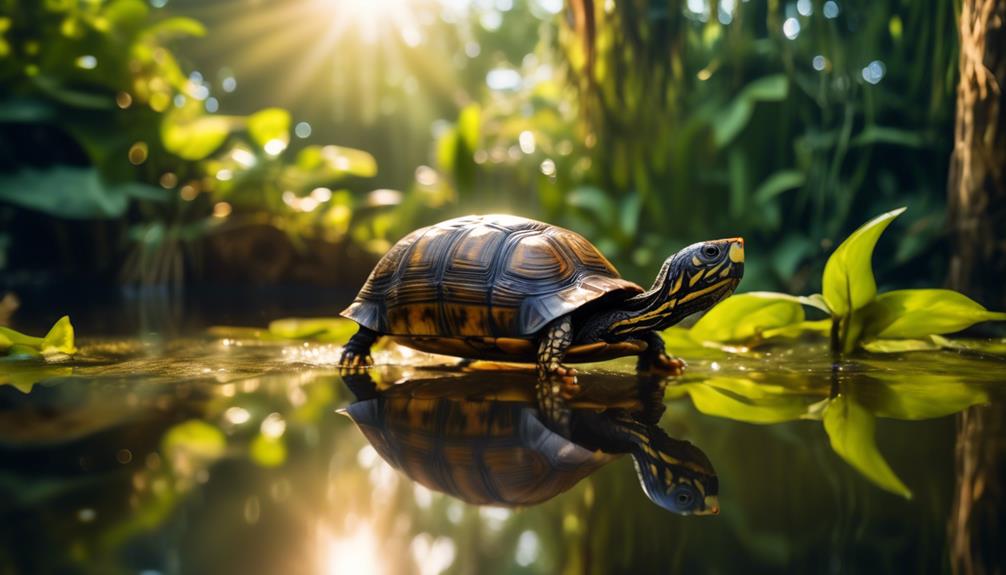
To ensure the health and well-being of your Florida Box Turtle, it’s important to understand their water requirements and consider certain factors. Here are three key considerations for providing optimal water conditions for your turtle:
- Clean and Fresh Water: Florida Box Turtles need access to clean, fresh water at all times. Ensure that their water dish or area is regularly cleaned and refilled to prevent the growth of bacteria or algae. This will help maintain their hydration and overall health.
- Soaking Opportunities: These turtles enjoy soaking in water to regulate their body temperature and aid in shedding. Provide a shallow dish or area with enough water for them to comfortably soak in. This will also allow them to drink and stay hydrated.
- Adequate Depth: While shallow water is suitable for soaking, Florida Box Turtles also need access to deeper water for swimming. Ensure that their enclosure has a larger water area with a depth of at least a few inches. This will provide them with the opportunity to swim and exercise their muscles.
Suitability as a Pet
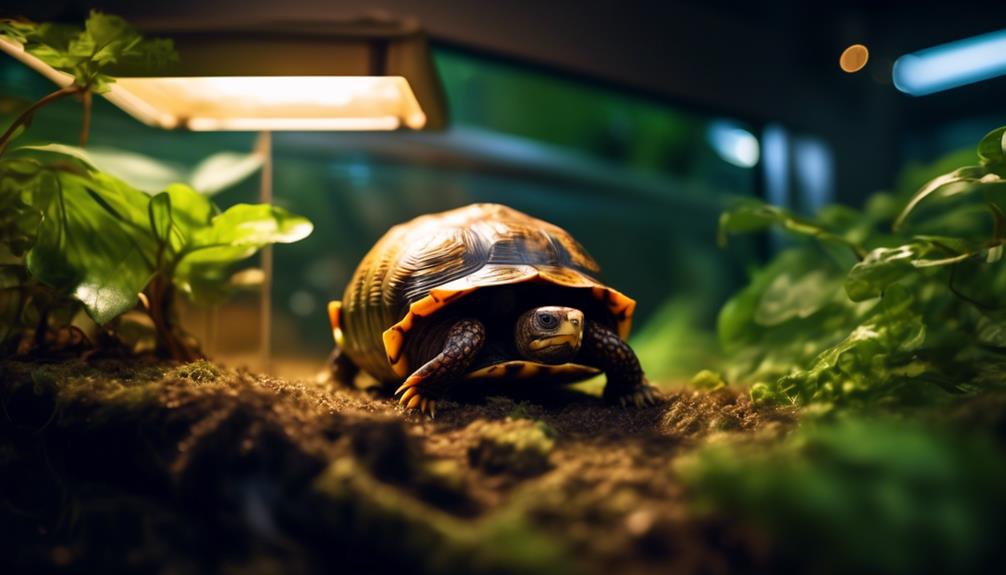
Now let’s explore the suitability of the Florida Box Turtle as a pet and what makes them a fascinating choice for experienced owners.
Florida Box Turtles are small terrestrial turtles with a lifespan of 50+ years. They require a varied diet consisting of pelleted commercial food, vegetables, fruits, worms, and insects.
These turtles are best housed in an outdoor enclosure that provides both sunlight and shaded spots. They aren’t fond of being handled, but they’re generally docile and don’t bite.
Florida Box Turtles can be kept with multiple turtles if enough space is provided and the ratio of females to males is maintained. They’re fun to observe and make great pets for experienced owners who are looking for a long-term commitment.
Behavior and Temperament
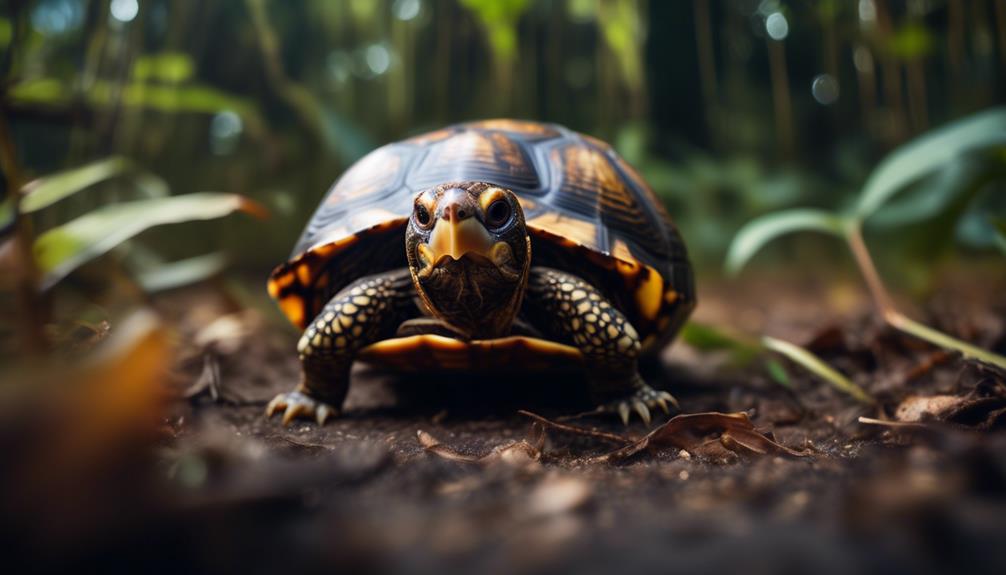
Florida Box Turtles exhibit interesting behavior and have a unique temperament that sets them apart from other pet turtles. Here are three fascinating aspects of their behavior:
- Shy and Withdrawn: Florida Box Turtles are known to be shy and prefer to retreat into their shells when they feel threatened. This behavior makes them elusive and adds to their mysterious allure.
- Curious Explorers: Despite their shy nature, these turtles are curious creatures. They enjoy exploring their surroundings and can spend hours investigating their environment, poking their heads out to observe the world around them.
- Territorial Defense: Florida Box Turtles are known to be territorial and will fiercely defend their territory against other turtles. They engage in territorial displays, such as head bobbing and shell ramming, to establish dominance.
Understanding the behavior and temperament of Florida Box Turtles is crucial for providing them with a suitable and enriching environment in captivity.
Social Dynamics and Breeding Behavior
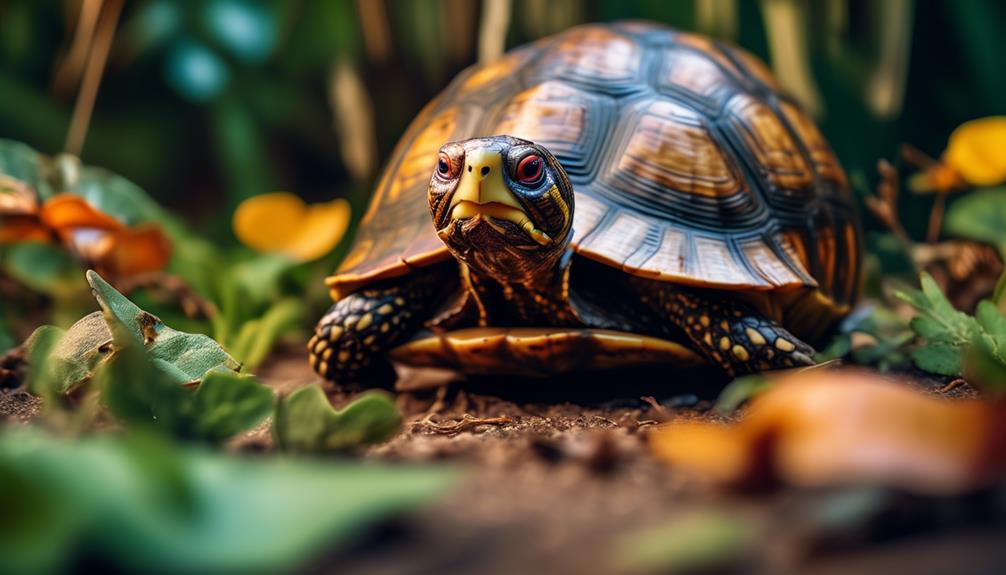
The social dynamics and breeding behavior of Florida Box Turtles offer fascinating insights into their interactions and reproductive strategies. These turtles are known to engage in complex social behaviors, particularly during the breeding season.
Male turtles are highly territorial and will aggressively compete for mates. They’ll engage in head bobbing, biting, and even flipping over rivals to establish dominance.
Once a male has successfully courted a female, mating occurs on land, typically in the spring or early summer.
Female turtles will then search for suitable nesting sites, often traveling long distances to find the perfect spot. They dig a hole, lay their eggs, and carefully cover them up before returning to their normal activities.
The incubation period lasts several months, after which the hatchlings emerge and begin their own journey.
Handling and Interaction Tips

After exploring the social dynamics and breeding behavior of Florida Box Turtles, it’s important to understand some handling and interaction tips for these fascinating creatures.
- Respect their space: Florida Box Turtles aren’t fond of being handled, so it’s best to observe them from a distance. Avoid picking them up unless absolutely necessary.
- Use gentle handling techniques: If you must handle a Florida Box Turtle, make sure to do so with care. Always support their body and avoid gripping or squeezing them. Remember, they have delicate shells that can be easily damaged.
- Limit handling time: Keep interaction sessions short and infrequent. Extended periods of handling can cause stress and discomfort for the turtles. Allow them ample time to rest and retreat to their natural habitat.
Conservation and Protection Efforts
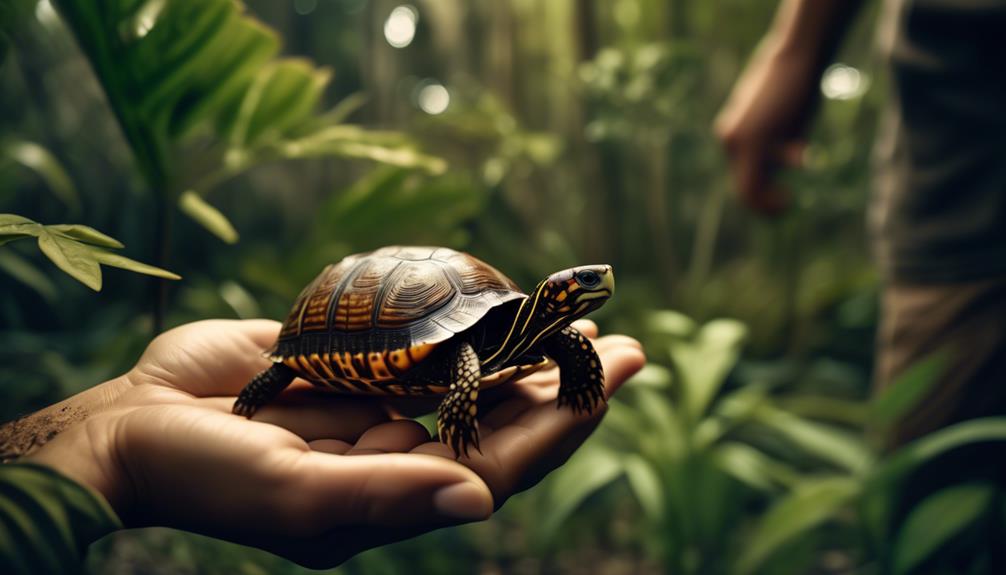
Efforts are being made to conserve and protect the Florida Box Turtle and its native habitat.
Conservation organizations and governmental agencies are working together to ensure the survival of this fascinating native species.
One of the major concerns is habitat loss due to urban development and agriculture.
To address this, initiatives are being taken to preserve and restore the natural habitats of the Florida Box Turtle, such as marshes, scrub areas, and forests.
These efforts include acquiring land for conservation, implementing land-use regulations, and raising awareness about the importance of protecting these habitats.
Additionally, measures are being taken to reduce threats from invasive species and pollution.
Frequently Asked Questions
How Can I Tell the Difference Between a Male and Female Florida Box Turtle?
To tell the difference between a male and female Florida box turtle, look for orange or bright red eyes in males and brown or dark red eyes in females. Males also have longer tails and hooked claws on their back feet.
What Are Some Common Health Issues That Florida Box Turtles May Experience?
Some common health issues that Florida box turtles may experience include respiratory infections, shell rot, parasitic infections, and vitamin deficiencies. Regular veterinary check-ups and proper care can help prevent and treat these issues.
Are Florida Box Turtles Endangered or Protected in Any Way?
Florida box turtles are not currently listed as endangered, but they are protected under state laws. It is important to respect their natural habitat and not disturb or remove them.
Can Florida Box Turtles Be Kept Indoors as Pets?
Yes, Florida box turtles can be kept as pets indoors. They require a secure enclosure with sunlight and shade, humidity of 70-90%, and a diet of invertebrates, plants, and insects.
Are There Any Specific Regulations or Permits Required to Own a Florida Box Turtle as a Pet?
No, there aren’t any specific regulations or permits required to own a Florida box turtle as a pet. However, it is important to understand their care requirements and provide a suitable environment for their well-being.
How Do Florida Softshell Turtles Compare to Florida Box Turtles in terms of Size and Lifespan?
Florida softshell turtles, known as aquatic giants, are significantly larger than Florida box turtles. The softshells can grow up to 24 inches in size, while box turtles usually reach 5-7 inches. In terms of lifespan, softshell turtles live longer, with an average of 30-40 years, compared to box turtles’ 30-40 years.
Conclusion
In conclusion, the Florida Box Turtle is a captivating native species with its unique characteristics and vibrant appearance.
Its ideal habitat and care requirements are essential to ensure its well-being.
Understanding its behavior and social dynamics can enhance interaction and breeding efforts.
As a responsible enthusiast or owner, it’s important to support conservation and protection efforts to preserve this elusive and fascinating turtle species for future generations to enjoy.

